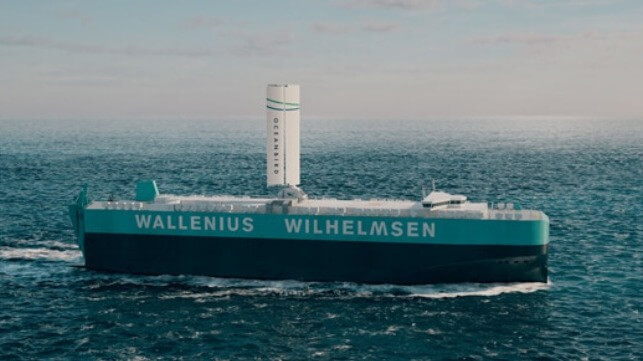Oceanbird Prepares for Full Scale Tests of Rigid Sail

Oceanbird, the joint venture between Alfa Laval and Wallenius Lines, reports it is continuing to make progress on its rigid sail concept for wind-assisted propulsion of large commercial ships. The company is moving toward the first full-scale tests of its sail as it looks to retrofit existing ships while also proceeding toward Orcelle Wind, a Pure Car Truck Carrier that would cut emissions by 90 percent through the primary use of wind propulsion.
During a presentation from London today the company outlined its next phases of development of the Oceanbird concept. After unveiling the concept in 2020, they spent the last year refining and completing the design for the wind sail. Smaller prototype testing, wind tunnel tests, and computer modeling have helped to refine the design concepts. In 2020, the company showed a telescoping sail which has evolved to a more efficient and less expensive to produce design that has a smaller telescoping section and tilts when not in use or to create clearance for navigation in harbors and under bridges. The mast and mount are made of high-strength steel, while the sail is a glass fiber sand composite.
The switch from the telescopic sail to the tilling sail reduced the size by half while still yielding the same thrust. Requiring less material, the sail is less costly to produce and suited for installation on many of the 60,000 commercial vessels currently in service. The wing sails in this first product line will be around 131 feet high and 45 feet wide. The company reports the design has a 40-knot structural limit but to reduce heel on the vessel they can tilt down the sail or remove the load from the sail in adverse weather conditions.
Oceanbird recently received €9 million grant from the EU’s Horizon Fund for a 60-month project to continue the testing and development of the commercial product. Niclas Dahl, Managing Director at Oceanbird says the project will be a critical step in validating the design work. It will also provide access to a broad base of stakeholders that will be required to develop the concept to implementation over the next four to five years.
“Nothing on this scale has been attempted,” notes Roger Strevens, VP Global Sustainability at Wallenius Wilhelmsen. Over the next two years, the company with the support of the Horizon Fund project plans to move the concept through its first full-scale testing while also addressing the need to train crews to handle the equipment.
Prototypes of the wing sail will be tested on land by the end of 2023. Dahl points out that the design is set and they are now ordering parts of the first tests. He expects the land testing will improve the mechanics and help to optimize the assembly. The land installation will also be used for crew training.
Wallenius Wilhelmsen’s in-service car carrier the Tirranna, a 30,000 dwt vessel with a capacity of 7,620 cars, will play a critical role in the next phase of testing. Coordinated with her scheduled dry dock in mid-2024, they plan to install a single sail for testing under real operating conditions. The team points out that extensive work is going into this phase of the testing, including calculations on the structural and stability issues to accommodate the sail. As part of the dry dock installation, they will be making modifications to the hull and structure of the vessel.
The companies see this project as part of the first transition in fuel and power supply for the shipping industry in over a century since the move from the previous use of sails and coal to power ships. They point to emerging environmental regulations and the need to accelerate the shipping industry’s transition from fossil fuels. Research shows that depending on the size of the ship and route, the Oceanbird rigid sail will produce a 7 to 10 percent reduction in fuel consumption and emissions.
AlfaWall Oceanbird seeks to become a provider to assist in the transition of in-service vessels to comply with the new EEXI and CII standards from the IMO. They expect to learn from the land and installed tests on the Tirranna highlighting that Ro-Ros are an early candidate as installation of the sails does not create visibility issues or concerns with cargo loading. The company expects to use the knowledge gained from the Ro-Ros to look to other vessels such as tankers, bulk carriers, and containerships for the installation of the rigid sail technology. In addition to the retrofits, their ambition is for the Orcelle Wind to commence sailing in late 2026 or early 2027.
